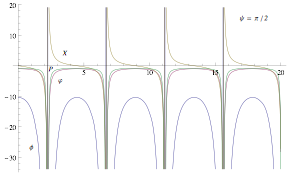Dr. Juan A. Valiente Kroon
Research
Dr. Juan A. Valiente Kroon
Research

Conformal properties of spacetime. I exploit conformal properties of the Einstein equations to obtain statements about the global existence and stability of solutions to the Einstein field equations. Conformal transformations allow to attach a conformal boundary to the spacetime representing ideal points at infinity. The main tool for this analysis are the so-called conformal Einstein field equations. Conformal techniques have been of great value in the analysis of asymptotically simple spacetimes like the Minkowski, de Sitter and anti de Sitter spacetimes. One of the current challenges consists on adapting these methods so that they can be used in the analysis of the stability of black hole spacetimes —for example the Schwarzschild and Reisner-Nordström solutions. I am currently writing a monograph in the topic (to be published by Cambridge University Press).
Geometric invariants and invariant characterisations. One of the difficulties in the analysis of stability of solutions to the Einstein field equations is to formulate in a precise and rigorous manner what it means that a certain solution is close to a specific exact solution of the theory. Together with some collaborators I have started a a research programme aimed at constructing geometric invariants (i.e. objects independent of the coordinate system used to compute them) which would address this difficulty. In particular, we have introduced the notion of non-Kerrness —a scalar associated to the leaves of a foliation of a spacetime which vanishes when the leaves are exactly an hypersurface of the Kerr spacetime. These ideas have unexpected connections with the notion of mass of a manifold and may provide alternative avenues to analyse outstanding open questions in General Relativity like the uniqueness of stationary black holes and the Penrose inequality. We are also adapting these ideas to evolution questions.

Transformation electromagnetics. A different stream of my research involves the application of the methods of Differential Geometry to the design of materials with exotic optical and electromagnetic properties. Of particular interest are so-called cloaking devices by means of which a particular shape becomes electromagnetically invisible and illusion devices through which it is possible to disguise a curved surface as another one. Most cloaking and illusion devices appearing in the literature have some sort of symmetry. I am currently engaged in a collaboration aimed at designing cloaking and illusion devices for arbitrary surfaces by means of materials with electromagnetic properties which can be realistically produced. It is expected that the resulting techniques can be applied to other types of waves in fields like acoustic and thermodynamics.
Global evaluation of spacetimes by means of numerical methods and computer algebra. The combination of the conformal Einstein field equations with a conformally privileged gauge opens the tantalising possibility of performing global numerical evaluation of spacetime. By means of these simulations one obtains a precise and detailed picture of the conformal structure of the spacetime under consideration. Current codes allows the evaluation of spherically symmetric vacuum and electrovacuum spacetimes with and without Cosmological constant. These simulations provide valuable insights into detailed analytic considerations about the nonlinear stability of black holes spacetimes. In a medium time frame, the idea is to extend these codes to include more general matter models like the conformally invariant scalar field and the Yang-Mills fields while retaining the spherical symmetry. On a a longer time frame, it is planned to extend the codes to consider non-symmetric configurations. The computer simulations are based on a Mathematica infrastructure in which the conformal field equations are manipulated using the suite xAct to obtain the required evolution equations. Older versions of the code (written in Maple) have allowed the computation of asymptotic expansions to analyse the structure of spatial infinity.



Interested in doing a PhD?
I am always in the search of good students. I will be glad to suggest problems involving the above current lines of research. For projects in General Relativity, basic background material is discussed in the notes to my LTCC course Mathematical Problems of General Relativity. More in-depth material can be found in my upcoming monograph Conformal Methods in General Relativity (in preparation).
In the media
My research (together with T. Bäckdahl) on the notion of non-Kerrness attracted some response in the media. See here for more details.